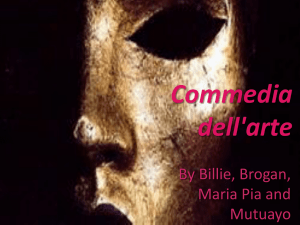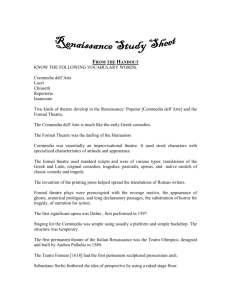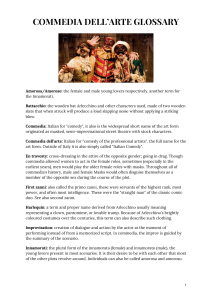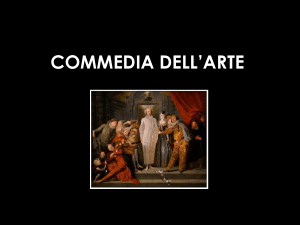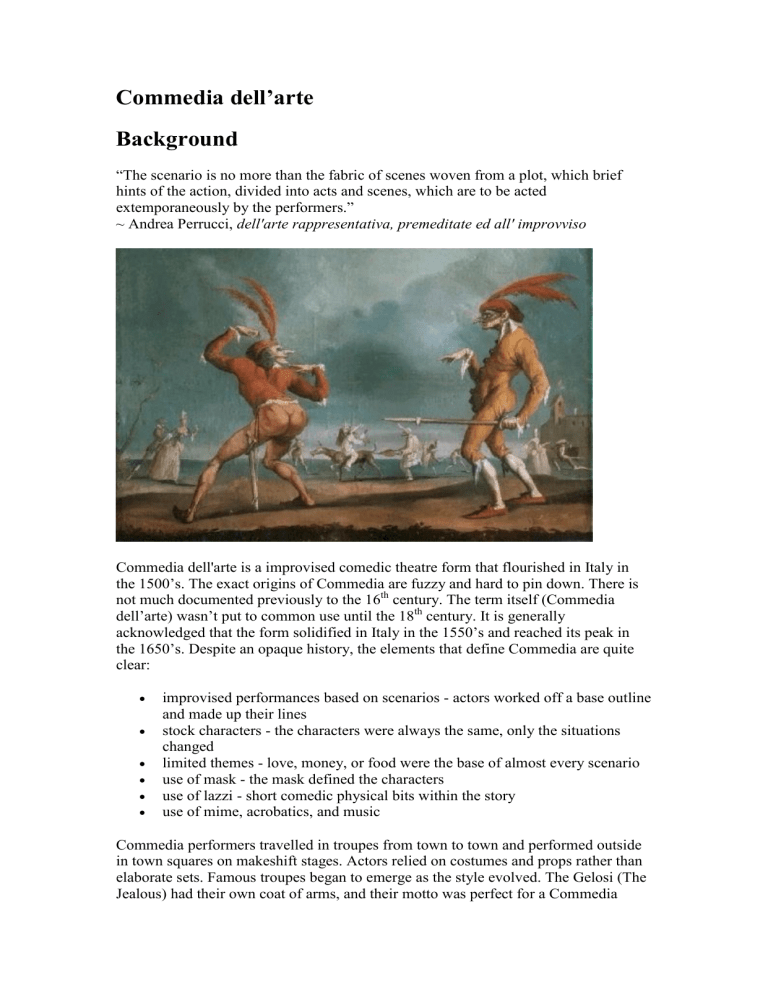
Commedia dell’arte Background “The scenario is no more than the fabric of scenes woven from a plot, which brief hints of the action, divided into acts and scenes, which are to be acted extemporaneously by the performers.” ~ Andrea Perrucci, dell'arte rappresentativa, premeditate ed all' improvviso Commedia dell'arte is a improvised comedic theatre form that flourished in Italy in the 1500’s. The exact origins of Commedia are fuzzy and hard to pin down. There is not much documented previously to the 16th century. The term itself (Commedia dell’arte) wasn’t put to common use until the 18th century. It is generally acknowledged that the form solidified in Italy in the 1550’s and reached its peak in the 1650’s. Despite an opaque history, the elements that define Commedia are quite clear: improvised performances based on scenarios - actors worked off a base outline and made up their lines stock characters - the characters were always the same, only the situations changed limited themes - love, money, or food were the base of almost every scenario use of mask - the mask defined the characters use of lazzi - short comedic physical bits within the story use of mime, acrobatics, and music Commedia performers travelled in troupes from town to town and performed outside in town squares on makeshift stages. Actors relied on costumes and props rather than elaborate sets. Famous troupes began to emerge as the style evolved. The Gelosi (The Jealous) had their own coat of arms, and their motto was perfect for a Commedia troupe: Virtu, fama ed honor ne fer gelosi - “We are jealous of attaining virtue, fame, and honor." “In size, the troupes averaged ten to twelve members; seven or eight men and three or four women. A typical troupe included two sets of lovers, a servant girl, a capitano, two zanni, and two old men...productions were supervised by the leader or most respected member of a troupe. It was the leader’s responsibility to explain the characters, clarify the action, enumerate the lazzi and acquire the properties needed.” ~ Oscar Brockett, History of the Theatre One unique difference with Commedia dell’arte in comparison to previous theatre eras is that women performed their roles (instead of being played by men). The most famous Commedia actress was Isabella Andreini, a member of the Gelosi. She was known for playing the female lover character, the Inamorata. Her tour de force performance was called Pazzia d'Isabella (Isabella's madness). During the show, Isabella goes mad by speaking several languages, singing in French, and imitating all of the other characters, male and female. After her death, her name became synonymous with the Inamorata role. The nature of the improv It’s a misconception to think of Commedia improvisation as actors just making everything up on the spot. Yes, the lines of the play would have been improvised each time they performed, but the actors were also following well laid out scenarios, well defined lazzi (each actor would have had several lazzi in their arsenal) and specifically detailed characters. Many actors only played one or two characters in their lifetime (like Isbella Andreini above) so they would have years of practice to draw on as they “improvised.” Since Commedia troupes (often comprised of close family members) spent all their time together, they would have worked well together as they brought the plays to life. What does “Commedia dell’arte” mean? There are a number of definitions of the phrase Commedia dell’arte: Artistic comedy Comedy of art Comedy of skills Comedy of professional artists Italian comedy Vocabulary battacio: Slap stick. Carried by Arlecchino. battute: Set dialogue that always happens between two specific characters. burla: Improvised comic bit or practical joke done by the servants, often involving 2 actors. concetti: A set character speech, something that a certain character always says. lazzi: A physical comic bit in the middle of the play unrelated to the plot. Each actor would have a number of lazzi in their repertoire. They were acrobatic, exaggerated, and often obscene. innamorati: The lovers. These were unmasked characters. Males are innamorato, females are innamorata. scenario: The outline of the play or scene. stock characters: Commedia characters are set and never change from play to play. They follow the same set of personality quirks, gestures, movements, masks and costumes regardless of who plays them. vecchio: The masters, usually old men. zanni: The servants. zibaldone: Reference book holding lazzi, concetti, battute, and stock phrases for a single character. Each actor had one. Characters “The characters have been compared to barnyard inhabitants. Hens, chicks, roosters, capons, ducks, peacocks - all the farmyard bipeds make us laugh, their walks absurd parodies of man's own gait. Pantalone, Arlecchino, Columbina, Smeraldina, Brighella, Capitano, Dottore and the others are not identified so much by the color and cut of their costumes as by the walk, the gesture, the manner in which each uses his "feathers" to express pride, joy, anger, and sorrow, alternately swelling and drooping, preening and ruffling, as he picks his way like a strutting fowl, ever vulnerable, across the stage before the appreciative eyes of the audience” - Carlo Mazzone-Clementi with Jane Hill, The Drama Review Character categories Commedia characters are not known for subtext or subtle back story. They are big, bold, and physically exaggerated. They know what they want, they say what they want and they go after what they want. But Commedia characters never get what they want. They never change, grow or develop in the course of a play. It’s an endless loop of heightened frustration, which is the heart of the comedy. The characters are fixed types who fall into one of three categories: The Servants (zani) The Masters (vecchi) The Lovers (innamorati) The masters are usually foolish greedy old men, and the servants are hungry and mischievous. The young lovers are always in love. Most of the characters wear masks, but even those without masks (e.g. the Lovers) treat their personas as masks. In Commedia, the characteristics of a character (such as a walk, a pose, or gesture) are just like wearing a mask. The Stock Characters “Commedia makes the actor the most important element in the play since language is negligible and plot is simple.” - Bari Rolfe, Commedia dell’arte: A Scene Study Book As the characters remain the same regardless of the story they're involved in, you would be able to recognize a Commedia stock character in an instant by how they move, what they wear, and how they act. Pantalone Old Venetian Merchant. Rich and greedy miser. Obsessed with money. Always after women and thinks he’s good at it. Gullible and often tricked. Costume: Red pants and top with a flowing black cloak. Has a money bag. Mask: Long pointed nose. Often has a moustache and bushy eyebrows. Movement: Leads with the forehead and has a hunched back with bent knees. Fluttery hands, which he tries to contain by clasping them behind his back. Always bent over trying to keep his money safe! Arlecchino Servant, poor, always wanting money, always hungry. Carries a bat/slapstick. Stupid and smart at the same time. Doesn’t want to work but eager to please. Costume: Tight fitting patchwork colourful costume. Mask: Black mask. Small eyes. Catlike face. Movement: Low status. Very acrobatic and quick. Leads with his knees and is very active, always on the move, never moving in a straight line. Think monkey. Innamorati The young lovers. (Innamorato & Innamorata) These characters are very much in love with love. They love each other, they love themselves. They carry mirrors so that they can look at themselves as often as possible. They act completely over the top in their infatuations like Soap Opera characters. They have no notion of the consequences of their actions, nor are they all that bright. They’re totally focused on the notion of love. Common female names are Isabella and Valentina. Common male names are Flavio, Leandro and Ottavio. They don’t wear masks, but do wear makeup. They are always young and attractive. Costume: Think Italian Renaissance Princes and Princesses. They are covered head to toe, perhaps excessively, in the best fashions and finery. Movement: High status. Whatever they do, it’s melodramatic and over the top. They glide instead of walk. They show pride in their appearance, and in how much they love themselves. Columbina Servant. Name means Little Dove. A female version of Arlecchino - quick wit, vain, never in love. Often a servant to Isabella, an Innamorata. Usually the smartest character on stage. Mask: Sometimes she wears a mask and sometimes not. If she does, it’s a small one that only covers the eyes. Costume: Often dressed in similar colours to Arlecchino. Cap and apron. Dressed as a lady’s maid. Movement: Though she’s a servant, and therefore low status, her movements correspond to her strong, quick-witted character. She stands with a hip cocked to the side, hands on hips. She moves with quick strong steps. Il Dottore Not often a real doctor, more likely a professor, a lawyer, philosopher. Often spouting knowledge at the most inopportune time. His diagnosis of any situation is always wrong and makes no sense. Never stops talking and what he talks is nonsense. Know it all, but knows nothing. Fat. Costume: Dressed in black academic garb. Black jacket (think graduation gown), black skullcap and a mortarboard. Mask: Only covers the forehead and the nose with the actor’s cheeks bare. Round nose. Movement: Focus on Il Dottore’s large size - it affects his movement. It’s all about the body. The weight is in the heels and the movement is slow. Think of a pig. Brighella The tough servant. Arrogant, violent, womanizer. No morals. Liar. Always on the pursuit for food. Ready for a fight. Ready for trouble. Costume: dressed as a servant, wears a white costume. Carries a dagger. Mask: A green half mask. Movement: Focus on the fact that he’s ready for a fight. Think of a big cat like a cheetah or a panther. Il Capitano It seems that Il Capitano is a man's man, a soldier, a warrior who brags about his exploits. But in fact, he just talks a big game. He has many war stories from conquests in Spain at the ready but really he’s a coward and a scaredy cat. Costume: He wears the trappings of traditional military garb. He also carries a sword, but never draws it. Mask: Long pointy nose. Movement: Seems like a high status character. Walks like a stereotypical hero - big movements, chest puffed out, shoulders square, marching steps, stands at attention. But then when he’s scared he immediately reverts to a low status character. Pulcinella Origin of name Punch from Punch and Judy. Melancholy. Hates all others and always works alone. Mostly a servant but can be a master as well. Costume: Dresses in white floppy clothes with a big floppy hat. Carries a stick. Mask: Black mask with a hook nose not unlike a bird beak. Pulcino in Italian means chick (as in bird). Movement: Walks and talks like a bird. Squawking and pecking. Stays hunched and close to the ground, except when he explodes out. Themes & Scenarios “Commedia needs lost souls (of both sexes) as well as honest ones. In it the refined is defined by contact with the unrefined, and the indelicate becomes delectable as a relief from the delicate.” - Olly Crick and John Rudin, Commedia dell'arte: A Handbook for Troupes One of the reasons Commedia actors were able to improvise with ease is that there weren’t a lot of different themes to draw from. It boils down to love, money, and food in their most exaggerated forms. The motivation for any Commedia character is to go to the ends of the earth to obtain one of the three. And since Commedia characters are a mix of high status and low status characters, you can be sure any story involves a clash between them. Since the dialogue was improvised it was also easy to add current events and local scandals to the story. I recently read a description of Commedia scenarios as “earthy,” which is a rather lovely way of saying Commedia can be downright obscene. True Commedia is not for the faint of heart! Many of the characters don’t pursue love per se, they seek out sex or adultery. Pantalone is often portrayed as a letch. The best way to describe the stories is that there is always someone who lusts after something: lusts after a person, after gold, after food. To keep that image in your mind is going to go a long way to finding the right tone in performance. Sample Commedia scenarios The young lovers wish to be married but their fathers deny their wish. This leads the servants to trick the old men into allowing the marriage. The Zanni trick one of the old men out of their money. Arlecchino is starving but keeps getting pulled away from his favourite food by his master, then the lovers, then every other character. Pantelone wants to date Isabella and turns to Arlecchino for advice, who in terms gives the worst advice possible. Capitano is new in town. He hears there’s a rich widow and turns to the zani to get help. Pantelone has a new young wife. He’s very jealous and instructs Arlecchino to keep all men away from her. Arlecchino does the opposite. Flaminio Scala, a Commedia actor from the 16th century published a collection of 50 scenarios called Il Teatro Delle Favole Rappresentative. Some of his scenario titles are: The Pranks of Isabella, The Old Twins, The Hunt, Flavio Betrayed, The Jealous Old Man, The Desperate Doctor, The Mirror, The Just Punishment, and The Fake Servants. Scenario Resources http://www.isebastiani.com/Scenarios.html http://math.bu.edu/people/jeffs/scenario.html https://sites.google.com/site/italianCommedia/plays-and-scenari http://www.amazon.com/Best-Commedia-DellArte-PlaysScenarios/lm/11HX9F9UR2GID Lazzi Lazzi (or Lazzo in the singular) are practised and predetermined comic bits. They could either be performed individually or in groups. Each actor has a repertoire of Lazzi at their disposal. Lazzi don’t connect to the plot or move the story forward. Their purpose is to make the audience laugh. Lazzi Resources http://www.amazon.com/Lazzi-Comic-Routines-CommediadellArte/dp/0933826699 http://shane-arts.com/Commedia-stock-characters.htm http://2011aisdramawiki.wikispaces.com/file/view/Physical%20Comedy.pdf/2 15691048/Physical%20Comedy.pdf Commedia Plays There are very few existing scripts for Commedia plays, as they were never written down. The one that many point to is The Servant of Two Masters, written in 1743 by Carlo Goldoni,an Italian playwright. We have our own Commedia script, The Scarlet Heart written by Allison Williams. A hungry, greedy crew lust after a huge gem. Of course, there’s not one competent thief in the bunch and even though Pantelone owns the gem, he’s not doing a great job of keeping it safe. See sample pages from The Scarlet Heart. Commedia in Performance The Commedia actor is a physical actor. The personality of each character is ground in the pose, the gesture, and the movement. Bigger is better, but what that really means is that the characters want something so much that they must move in an exaggerated fashion to get it. The want is connected to the movement. Allison Williams wrote the following when I asked her, “What should actors strive for in a Commedia performance?” 1. Commitment to action - the characters act on their thoughts just as Shakespeare's characters speak all their thoughts. 2. Truth in size - a larger size of character, but it doesn't feel fake cartoon-y, because they're really committed - like The Simpsons can still move the audience, because even though it's absurd, it's committed. 3. Understanding of the characters' drives - they want something and they want it single-mindedly and bad. No subtle drives - they want love, money, food. 4. Physical commitment - clean, big gestures and actions, it doesn't have to be huge acrobatics, but definite choices made about their bodies and how their characters move, and interesting looking positions when they are standing still (they should look like a statue of the character when they aren't in motion). 5. If they're in mask, focusing the masks, where the mask looks like part of the face (especially active mouths, where the mouth is as big as the mask) and where they lead with the mask and use it to direct focus and attention. If they aren't in mask, interesting use of props and body positions to make the "mask" of the character (i.e. if a lover has a fan, or Pantalone has a money bag, that's their mask, and how does their use of it express character like a cat switching its tail).
